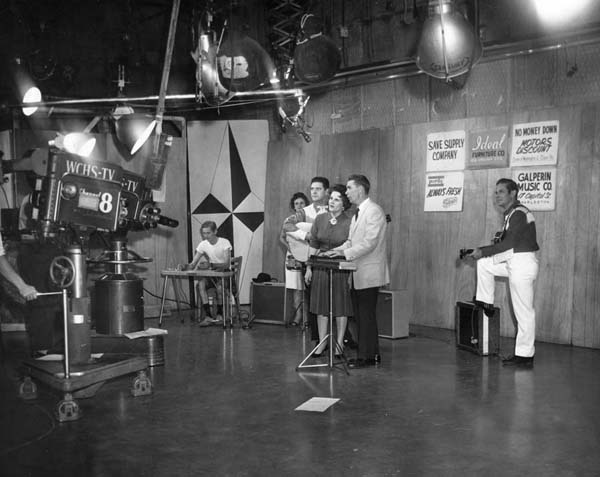Live Country Music on TV!
The Buddy Starcher and Sleepy Jeffers Shows
By Ivan M. Tribe

The Buddy Starcher Show was broadcast each morning from January 1960 until late 1966, when it was succeeded by The Sleepy Jeffers Show, until 1973.
This photograph shows a live broadcast from the mid-1960's featuring, from the left, Herman Yarbrough, Honey (Davis) Jeffers, Sleepy Jeffers, Mary Ann Starcher, Wick Craig, and Sonny Davis.
For 13 years between 1960 and 1973, music fans in the Charleston area could tune in each morning to live country music on WCHS-TV. Beginning with The Buddy Starcher Show, which ran from 1960 till 1966, to its successor The Sleepy Jeffers Show, local TV viewers enjoyed daily down-home entertainment, music, and comedy.
Buddy Starcher had some 30 years of radio experience behind him, both in West Virginia and in other states. Born in Ripley on March 16, 1906, Oby Edgar Starcher grew up in Nicholas County and quickly took the nickname “Buddy.” He learned the fundamentals of traditional music from his old-time fiddler father, Homer Francis Starcher, whom he learned to accompany at local dances on banjo and guitar. As a young man, Buddy was something of a vagabond and roamer, first singing on radio at WBFR in Baltimore in October 1928.
Following these first efforts as a radio vocalist, Buddy embarked on a long career via the airwaves. This involved frequent relocations as he either “played out the territory” or received more lucrative offers elsewhere. Wherever he played, Starcher won over a substantial fan base with a simple, sincere singing style. He also earned a reputation as a quality on-the-air salesman. His sojourns took him westward to Iowa and southward to Florida, but he always returned periodically to West Virginia. Buddy spent three prior stints at both WCHS in Charleston and WMMN in Fairmont, as well as one at WPDX in Clarksburg. He also made some notable recordings, chiefly on the Four Star and Columbia labels. For some years, he also worked in radio station management, but early in 1958 got back into entertainment at WSVA in Harrisonburg, Virginia, where he had been once before in 1941 and 1942.
When Buddy resumed active performing in the Shenandoah Valley, he did both radio and television. His band at that time included his wife, Mary Ann Vasas; Princeton fiddler Ralph “Joe” Meadows, who had earlier worked with the Stanley Brothers, including fiddling on their classic Mercury rendition of “Orange Blossom Special”; and a steel guitarist-comedian named Herman Yarbrough (aka Roscoe Swerps). The latter, a native of Winston-Salem, North Carolina, where he was born on August 14, 1930, had gotten into music and radio in 1947 with a country band called the Blue Star Boys. Over the next few years he developed his comic character of Roscoe. After the Blue Star Boys dissolved Yarbrough was out of music briefly before joining Buddy’s new group at Harrisonburg and becoming a close associate for some eight years.
Starcher started recording again for Starday Records, cutting six sides in 1959 and many more after he came back to Charleston. This was the era of the “saga” song, and his earliest releases included covers of “The Battle of New Orleans” and “Soldier’s Joy,” a pair of Jimmie Driftwood lyrics set to old fiddle tunes. He also did new originals like “Running Away from the Blues” and a saga song of his own, “Billy the Kid.”
In the last weeks of 1959, the Starcher gang relocated briefly to WHTN (now WOWK) Channel 13 in Huntington, sponsored by a mobile home dealer. This seemed to be a holding action, because the real plan was to inaugurate an hour-long daily morning show at WCHS-TV in Charleston, which started in January 1960.
You can read the rest of this article in this issue of Goldenseal, available in bookstores, libraries or direct from Goldenseal.